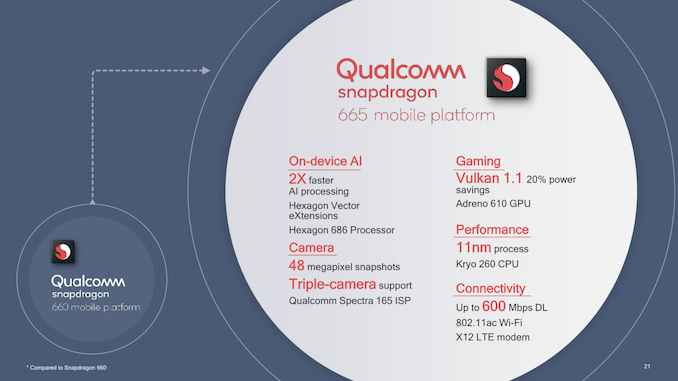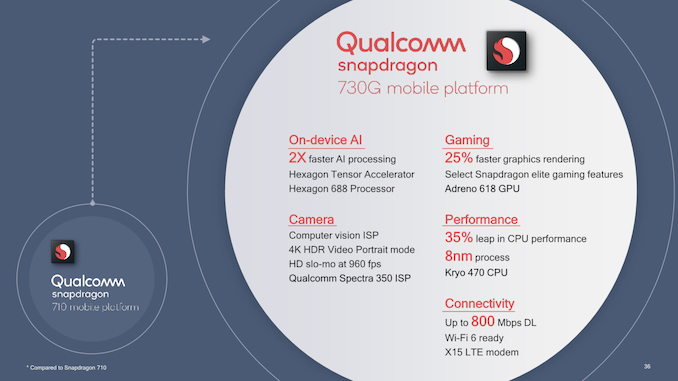Qualcomm Announces Snapdragon 665 & 730 Platforms: 11 & 8nm
by Andrei Frumusanu on April 9, 2019 12:30 PM EST- Posted in
- Mobile
- Qualcomm
- SoCs
- Snapdragon 665
- Snapdragon 730

Today at Qualcomm’s AI Day in San Francisco we saw the reveal of the new Snapdragon 665 and Snapdragon 730 SoCs and platforms. The new chipsets represent updates to Qualcomm’s mid-range and upper-mid-range line-up in the 600 and 700 series. In the last year we’ve seen Qualcomm be particularly active in these segments, pushing out new platforms in extremely quick fashion. Seemingly the reason for this quick succession is that these product segments are extremely cut-throat in terms of price sensitivity, and having new products exactly tailored to customer’s needs often will give one the competitive edge and the desired design wins.
Due to the sheet numbers of Snapdragon SKUs, we’re listing again the recent generations in these two segments to try to put today’s new products into context:
| Qualcomm Snapdragon Upper Mid-Range SoCs | ||||||
| SoC | Snapdragon 660 |
Snapdragon 665 | Snapdragon 670 |
Snapdragon 675 |
Snapdragon 710 |
Snapdragon 730 |
| CPU | 4x Kryo 260 (CA73) @ 2.2GHz 4x Kryo 260 (CA53) @ 1.8GHz |
4x Kryo 260 (CA73) @ 2.0GHz 4x Kryo 260 (CA53) @ 1.8GHz |
2x Kryo 360 (CA75) @ 2.0GHz 6x Kryo 360 (CA55) @ 1.7GHz |
2x Kryo 460 (CA76) @ 2.0GHz 6x Kryo 460 (CA55) @ 1.7GHz |
2x Kryo 360 (CA75) @ 2.2GHz 6x Kryo 360 (CA55) @ 1.7GHz |
2x Kryo 470 (CA76) @ 2.2GHz 6x Kryo 470 (CA55) @ 1.8GHz |
| GPU | Adreno 512 | Adreno 610 | Adreno 615 | Adreno 612 | Adreno 616 | Adreno 618 |
| DSP | Hexagon 680 | Hexagon 686 | Hexagon 685 | Hexagon 688 | ||
| ISP/ Camera |
Spectra 160 24MP |
Spectra 165 25MP single / 16MP dual |
Spectra 250 25MP single / 16MP dual |
Spectra 250 25MP single / 16MP dual |
Spectra 250 32MP single / 20MP dual |
Spectra 350 36MP single / 22MP dual |
| Memory | 2x 16-bit @ 1866MHz LPDDR4 14.9GB/s |
2x 16-bit @ 1866MHz LPDDR4X 14.9GB/s 1MB system cache |
||||
| Integrated Modem | Snapdragon X12 LTE (Category 12/13) DL = 600Mbps 3x20MHz CA, 256-QAM UL = 150Mbps 2x20MHz CA, 64-QAM |
Snapdragon X15 LTE (Category 15/13) DL = 800Mbps 3x20MHz CA, 256-QAM UL = 150Mbps 2x20MHz CA, 64-QAM |
||||
| Encode/ Decode |
2160p30, 1080p120 H.264 & H.265 |
2160p30, 1080p120 H.264 & H.265 10-bit HDR pipelines |
||||
| Mfc. Process | 14nm LPP | 11nm LPP | 10nm LPP | 11nm LPP | 10nm LPP | 8nm LPP |
Snapdragon 665
Starting off with the new Snapdragon 665, the new chipset represents a direct update to the Snapdragon 660 announced back in 2017. Qualcomm’s positioning here is quite weird as the new S665 isn’t as highly positioned as the S660 was back then; the Snapdragon 665 instead yet again creates a lower-end within the mid-range 600 series, but then again it’s still positioned higher than the 630 or 650’s series of past.
On the CPU side, not much has changed in comparison to the Snapdragon 660: There’s still 4x Kryo 260’s based on Cortex A73’s plus 4x Cortex A53 based cores. In fact the new chipset’s clock is actually lower, featuring only 2GHz big cores versus the 2.2GHz predecessor. The small cores are still clocked in at 1.8GHz.
On the GPU side however we see big upgrades with the new Adreno 610 GPU which should be a big generation jump. The Hexagon DSP also has seen a generational upgrade to a new 686 block.
Memory controller, media capabilities as well as the modem remain the same. What is to be noted however is that the new chipset is upgraded to an 11LPP manufacturing process which should bring power savings and cost reduction compared to its predecessor.
Snapdragon 730
The Snapdragon 730 is a more interesting generational upgrade. Here the new chipset is seemingly a successor to the Snapdragon 710 announced last year. We actually expected this chipset for a while, but were surprised Qualcomm announce the Snapdragon 675 instead last October. The odd thing about the S675 announcement was that it came with a CPU combination that was inherently superior to the higher tier Snapdragon 710.
The new S730 now solves this weird positioning situation as it now also upgrades its CPU microarchitecture to a “Kryo 470” CPU configuration, which is based off Arm’s Cortex A76 CPU µarch. The cores are clocked at 2.2GHz and are accompanied by 6x Cortex A55 cores at up to 1.8GHz.
We also see a new iteration of the Adreno GPU in the form of the Adreno 618. The new unit promises 25% increased performance over its predecessor.
Important for the Snapdragon 730’s differentiating factor is the fact that it comes with the latest generation Hexagon 688 DSP which includes Qualcomm’s new Tensor Accelerator units for machine learning inferencing.
The new chip’s imaging capabilities are also top-tier with the inclusion of the Spectra 350 ISP, including CV (computer vision) acceleration. In fact the inclusion of these high-end features that we tend to see in the flagship 800 series is the 700 series’ key characteristic: Providing the same features within a lower performance and more cost-effective package.
The new Snapdragon 730 is also Qualcomm’s first chipset manufactured on Samsung’s new 8nm LPP manufacturing node which represents a second-to-best process choice for this generation.
Qualcomm will also deliver a Snapdragon 730G variant of the chipset promising 15% greater graphics performance, a bin variant of the Snapdragon 730 with higher clock speeds.
The new chipsets are expected to be available in commercial devices in mid-2019.
Related Reading
- Qualcomm Announces Snapdragon 675 - 11nm Mid-Range Cortex A76-Based
- Qualcomm Reveals The Snapdragon 670 Platform: Dual Big Cores + Adreno 615
- Samsung Details 11LPP Process Technology: 10 nm BEOL Meets 14 nm Elements
- Qualcomm Announces Snapdragon 710 Platform
- Qualcomm Announces Snapdragon 700 Series Platform: Carving Out A Niche for Sub-Premium
- The Snapdragon 845 Performance Preview: Setting the Stage for Flagship Android 2018
- Qualcomm Announces Snapdragon 660 & 630 Mobile Platforms: Better Connectivity, Camera, & Compute at 14nm














20 Comments
View All Comments
Wardrive86 - Tuesday, April 9, 2019 - link
Not to mention the memory bandwidth is half that of the SD845 and the system cache is 1/3. Even if it was as powerful as a 630 (not likely) it would be greatly diminished by that bandwidth.levizx - Tuesday, April 9, 2019 - link
I don't believe 665 has any "generation jump", it's a direct die shrink of 660 with perhaps minimal hardware tweaks. Otherwise it would have been way too expensive to design compared to just underclock 675.Valantar - Wednesday, April 10, 2019 - link
Considering it has a new GPU, DSP and ISP, that is obviously not the case. A direct die shrink would mean zero architectural changes.levizx - Monday, May 20, 2019 - link
And you know those are new because they have a new name?spaceship9876 - Tuesday, April 9, 2019 - link
They should release a quad cortex a55 cpu for the low end, i think that would be popular, use 12nm or something for it and add support for AV1 hardware decoding/encoding.levizx - Wednesday, April 10, 2019 - link
AV1 is unrealistic before late 2020. And Quad A55 on 1x mm provides no improvement over Octa A53 while costing tens of millions to design and support.They have to have 6+2 chips, so it makes more sense to just disable the big core on that and sell it for the niche market.
levizx - Wednesday, April 10, 2019 - link
*nmanonym - Saturday, April 13, 2019 - link
SpreadTrum(formally UNISOC) announcedocta A55@28nm and 1xA75+3xA55 chip. I don't know which manufacturer use it
c933103 - Wednesday, April 10, 2019 - link
What about the 730G? Is that just higher-clocked GPU?c933103 - Wednesday, April 10, 2019 - link
The article here say "Qualcomm will also deliver a Snapdragon 730G variant of the chipset promising 15% greater graphics performance, a bin variant of the Snapdragon 730 with higher clock speeds." but Qualcomm's site said 730G will have maximum clock of 2.2GHz which is same as the non-G 730.